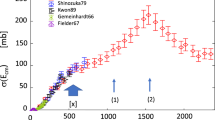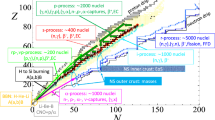Abstract.
Experimental studies of nuclear reactions of astrophysical interest are hampered by the exponential drop of the cross-section with decreasing energy. Generally, the effects of the projectile energy loss in the target cannot be neglected and the reaction yield is proportional to the average value of the cross-section over the interaction energies inside the target. Local cross-section values, instead of averaged, are needed to evaluate stellar reaction rates. To deal with this, several different effective interaction energy definitions have been introduced during the years, leading to potentially discrepant results. Thus, a well-defined procedure for data reduction is required. This work briefly reviews the theoretical ground for the experimental cross-section data reduction and the effective interaction energies definitions up to now introduced. The self-consistent approach introduced by B.W. Filippone et al. is discussed and its application to the data analysis of non-resonant and narrow-resonant reactions is presented. A comparison of the results obtained using the different approaches is also reported.
Similar content being viewed by others
References
C. Rolfs, W.S. Rodney, Cauldrons in the Cosmos (University of Chicago Press, Chicago, 1988).
C. Angulo, Nucl. Phys. A 656, 3 (1999).
C. Arpesella, Nucl. Instrum. Methods Phys. Res. A 360, 607 (1995).
P.R. Wrean, C.R. Brune, R.W. Kavanagh, Phys. Rev. C 49, 1205 (1994).
B.W. Filippone, Phys. Rev. C 28, 2222 (1983).
W.H. Press, S.A. Teukolsky, W.T. Vetterling, B.P. Flannery, Numerical Recipes in C: The Art of Scientific Computing, second edition (Cambridge University Press, 1992).
A. Lemut, unpublished.
C. Casella, Nucl. Phys. A 706, 203 (2002).
H.H. Andersen, J.F. Ziegler, Stopping Powers and Ranges in All Elements (Pergamon Press, 1977) (updated data are available on-line at http://www.srim.org).
H.J. Assenbaum, K. Langanke, C. Rolfs, Z. Phys. A 327, 461 (1987).
G. Imbriani, Eur. Phys. J. A 25, 455 (2005).
C. Iliadis, Nuclear Physics of Stars (Physics Textbook, WILEY-VCH Verlag GmbH & Co. KgaA, Weinheim, 2007).
Author information
Authors and Affiliations
Corresponding author
Additional information
E. Bellotti
Rights and permissions
About this article
Cite this article
Lemut, A. The definition of the effective interaction energy for astrophysical relevant reactions. Eur. Phys. J. A 36, 233–241 (2008). https://doi.org/10.1140/epja/i2008-10585-6
Received:
Accepted:
Published:
Issue Date:
DOI: https://doi.org/10.1140/epja/i2008-10585-6




